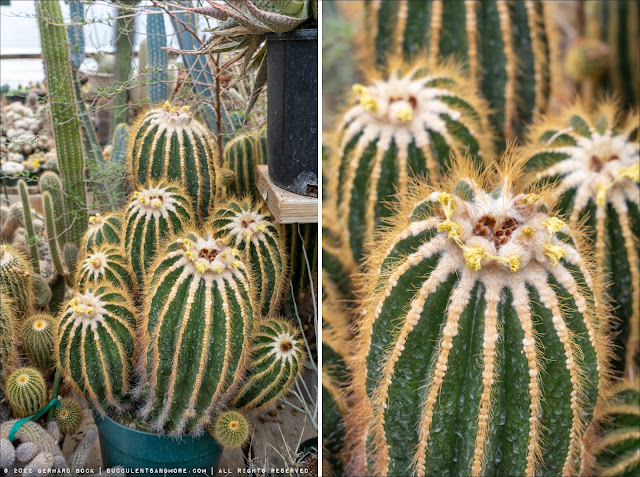⮌ Click here to read part 1 of this post
Our tour of the Poots' private greenhouse was led by Roelyn Poot, the matriarch of the family.
 |
| Roelyn Poot talking about the beginnings of the nursery |
I don't know how many plants are in the greenhouse, and I'm fairly sure the Poots don't either. Easily thousands. A good half are cacti, the rest euphorbias, caudiciforms, and succulents like agaves, aloes and haworthias. While there are some fairly common plants, albeit mature specimens, many are true collector's items. There was a lot of oohing and aahing as we were walking through the aisles.
 |
| This is the very definition of “packed” |
I felt overwhelmed at the thought of having to take care of such a large collection. Watering alone—a task performed by the Poots' daughter—looks to be an exceedingly time-consuming affair.
The collection is very well maintained. I saw no weeds and virtually no damage. Rats are a problem, but the packets of poison I spotted in many places seem to do the trick. Maybe chewed-on plants get sequestered to a special area while they recover?
 |
| Melocactus collection |
 |
| A Melocactus with a particularly tall cephalium |
Bill Poot has been a collector for almost 40 years, and what we saw is, in many ways, a historical collection encompassing a wide range of succulents.
Ariocarpus and
Copiapoa are among Bill's favorite genera. Coincidentally, they are among the most sought-after cacti among serious collectors.
 |
| Ariocarpus collection (left: Ariocarpus furfuraceus) |
 |
| Copiapoa krainziana |
 |
| Copiapoa krainziana (left), Copiapoa coquimbana (right) |
 |
| Copiapoa dealbata |
 |
| Copiapoa columna-alba |
I do have an interest in cacti, but it's more as an amateur admiring their myriad forms rather than a collector. The only succulents I “collect” (and I use that term loosely) are agaves. As a result, I was happy taking photos without wishing I could take this plant or that plant home with me (a pointless wish since none of these are for sale).
 |
| Turbinicarpus collection |
 |
| Turbinicarpus sp. |
 |
| Thelocactus hexaedrophorus var. fossulatus |
 |
| Parodia magnifica |
 |
| Tephrocactus geometricus |
 |
| Mature Astrophytum ornatum |
 |
| Eulychnia castanea f. varispiralis |
 |
| Sulcorebutia arenacea |
 |
| Spineless golden barrel (Echinocactus grusonii f. inermis) |
 |
| Agave victoriae-reginae 'White Rhino' |
 |
| Agave attenuata 'Variegata' |
 |
| A perfect mound of Deuterocohnia brevifolia |
 |
| Crested Aeonium 'Sunburst' |
 |
| Euphorbia decaryi |
 |
| Euphorbia decaryi |
 |
| Euphorbia flanaganii |
 |
| Monkeytail cactus (Cleistocactus winteri ssp. colademonis) |
 |
| Golden rat's tail cactus (Cleistocactus winteri ssp. winteri). This 20- to 25-year-old specimen originally belonged to another collector. His water had a high iron content, which caused the spines to turn dark brown. |
 |
| Pelecyphora aselliformis, in my mind one of the strangest looking cacti. The pectinate spines resemble insects. In fact, the species is named after the woodlouse (Oniscus asellus). |
 |
| Ferocactus sp. with sectional variegation |
 |
| No ID, but possibly a Rebutia |
 |
| No ID either |
 |
| Adenium flowers |
 |
| Haworthia truncata |
 |
| Haworthia truncata |
Many of the plants in the greenhouse are also used for propagation, as you see above and below:
 |
| Gasteria 'Shinano Fuji' |
 |
| Seedlings protected by a sturdy screen against hungry rat mouths |
 |
| Right: ×Ferobergia seedlings (intergeneric cross between a Ferocactus and Leuchtenbergia principis) |
 |
| My favorite plant label ever: “?” |
 |
| Dorstenia gigas flower. The tiny dots you see are individual flowers. Apparently, the Poots propagate Dorstenia gigas from seed. |
 |
| This is the flower of a Senecio, but I wasn't able to figure out which species. |
 |
| Sacramento Cactus and Succulent Society group with Bill Poot (third from right) |
Here are some YouTube videos about the nursery and the Poots' private collection. They're well worth watching if you have some time:
© Gerhard Bock, 2022. All rights reserved. To receive all new posts by email, please subscribe here.
















































Some extraordinarily beautiful specimens -- who knew Astrophytum ornatum eventually grew columnar? I was very taken by this remark: "I do have an interest in cacti, but it's more as an amateur admiring their myriad forms rather than a collector. The only succulents I “collect” (and I use that term loosely) are agaves." That remark wouldn't surprise coming from a lot of other bloggers, including me, but it surprises me coming from you! Your level of "amateur" involvement is very impressive!
ReplyDeleteSo much weird and wonderful. Eulychnia castanea f. varispiralis - surely the magical unicorn of the plant world?
ReplyDeleteOn reading that Pelecyphora aselliformis was named for its resemblance to the woodlouse, in my mind's eye, it become a seething mass of that particular critter and I must admit I freaked out a little.
Awesome tour - thanks Gerhard!
I'm overwhelmed just looking at the photos! I attended the local Cactus & Succulent Society's show and sale this past weekend. While they had a few of the same varieties you photographed, I can't honestly say any of those eclipsed those you've shown here.
ReplyDeleteWow! what an incredible collection of cacti, so many cool and unusual varieties some of which I have never heard. I always wonder with passionate collectors if they appreciate the plants more as individuals or is it more about the collection as a whole? With a collection as big as this it would be hard to remember what is there.
ReplyDeleteWow, fantastic growers and their garden center! I looked at the videos on YouTube also. Some of the largest and most beautiful cactus I have ever seen. You can just tell how the Poots love the plants!
ReplyDelete